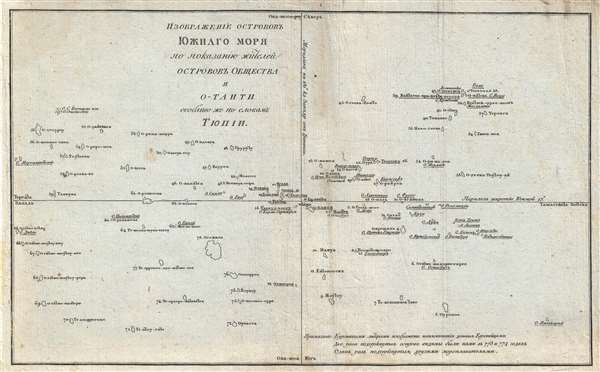Digital Image: 1777 Tupaia Indigenous Map of Tahiti and the Society Islands (in Russian)
TahitiSocietyIslands-tupaia-1777_d
Description
FOR THE ORIGINAL ANTIQUE MAP, WITH HISTORICAL ANALYSIS, CLICK HERE.
Digital Map Information
Geographicus maintains an archive of high-resolution rare map scans. We scan our maps at 300 DPI or higher, with newer images being 600 DPI, (either TIFF or JPEG, depending on when the scan was done) which is most cases in suitable for enlargement and printing.
Delivery
Once you purchase our digital scan service, you will receive a download link via email - usually within seconds. Digital orders are delivered as ZIP files, an industry standard file compression protocol that any computer should be able to unpack. Some of our files are very large, and can take some time to download. Most files are saved into your computer's 'Downloads' folder. All delivery is electronic. No physical product is shipped.
Credit and Scope of Use
You can use your digial image any way you want! Our digital images are unrestricted by copyright and can be used, modified, and published freely. The textual description that accompanies the original antique map is not included in the sale of digital images and remains protected by copyright. That said, we put significant care and effort into scanning and editing these maps, and we’d appreciate a credit when possible. Should you wish to credit us, please use the following credit line:
Courtesy of Geographicus Rare Antique Maps (https://www.geographicus.com).
How Large Can I Print?
In general, at 300 DPI, you should at least be able to double the size of the actual image, more so with our 600 DPI images. So, if the original was 10 x 12 inches, you can print at 20 x 24 inches, without quality loss. If your display requirements can accommodate some loss in image quality, you can make it even larger. That being said, no quality of scan will allow you to blow up at 10 x 12 inch map to wall size without significant quality loss. For more information, it is best consult a printer or reprographics specialist.
Refunds
If the high resolution image you ordered is unavailable, we will fully refund your purchase. Otherwise, digital images scans are a service, not a tangible product, and cannot be returned or refunded once the download link is used.
Cartographer
Tupaia (c. 1725 - December 26, 1770), also known as Tupaea or Tupaya, was a Tahitian navigator, artist, and arioi, or priest, of the war god 'Oro. He was born on the island of Ra'iatea near Ha'amanino Harbour, in the Society Islands. Following in a family tradition he became an ariori priest for the Taputapuatea marae. Tupaia was trained in the fare-'ai-ra'a-'upu, or schools of learning, about the origin of the cosmos, genealogies, the calendar, proverbs and histories. Additionally, his grandfather passed on to him traditional secrets of Tahitian oceanic navigation. When Ra'iatea was invaded by warriors from BoraBora in 1763, he fled to Tahiti where he became a prominent priest. When the English under Captain James arrived in June of 1769, he became fascinated by the strange Europeans. He attached himself to Samuel Wells and alter Joseph Banks. Under the patronage of Banks, but against Cook's better judgment, Tupaia joined the crew of the H. M . S. Endeavour. During his short stint on the Endeavour, he completed several watercolors, helped with navigation, and drew an important map of the Society Islands, the first examples of indigenous Polynesian cartography to make its way to Europe. Nonetheless, Tupaia remained unpopular with Cook, but had his grudging admiration, as described by Joseph Marra, a midshipman on the Endeavour,
Toobia ... was a man of real genius, a priest of the first order, and an excellent artist: he was, however, by no means beloved by the Endeavour's crew, being looked upon as proud and austere, extorting homage, which the sailors who thought themselves degraded by bending to an Indian, were very unwilling to pay, and preferring complaints against them on the most trivial occasions.With Tupaia's help the Endeavour made its way to Australia where they landed at Botany Bay in April of 1770. In November of that same year, the Endeavour landed in Batavia for repairs. There Tupaia contracted either dysentery or malaria from which he died shortly thereafter on December 26, 1770. More by this mapmaker...

